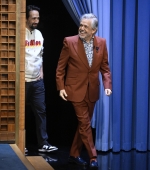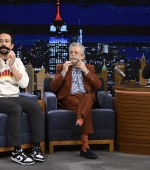We collected the inteviews, video and written, that Lin-Manuel Miranda gave so far to promote In The Heights movie.
Let’s start with Nerd Of Color.
Under the cut you can find more interviews, videos and articles: TheaterMania, Celebrity Page TV, The A.V. Club, Broadway.com, IndieWire, NYCGO, The Chicago Tribune, GMA News Online and The Daily Texan
INDIEWIRE: As the musical visionary behind In the Heights and Hamilton, Lin-Manuel Miranda has emerged as one of the biggest cultural figures of the past decade, and played a major role in the popularization of Latino storytelling. Or is that Latinx storytelling?
In recent years, debates have festered around the best term to describe people from Spanish-speaking countries and territories — including Miranda, the child of Puerto Rican parents and a Mexican grandparent. But even this wordsmith hasn’t settled on a specific term to describe his background.
“What you run up against are the limits of defining 32 different fucking countries with one world,” Miranda said in a recent interview with IndieWire. “Literally, no word is going to make everyone happy.”
In conversation, Miranda often defaults to describing himself and others as Latinos, the most natural term for native Spanish speakers. However, Miranda noted that the debate over “Latino” predates the existence of ‘Latinx’ and variants thereof. “When I was in high school, every week, the Latino club would debate ‘Latino’ versus ‘Hispanic,'” he said. “Now ‘Hispanic’ has really fallen into the rearview, and it’s all these variations on the rear-end of the word.” These include not only ‘Latinx’ but ‘Latiné,’ the gender-neutral term more commonly used by people of Latin descent in the LGBTQ community. “Latiné is great because it’s Latino-created,” he said. “I’m cool with all of it. I use them interchangeably because I think the pie is still cooling and it will never be perfect, because it’s trying to capture too much stuff.”
In any case, Miranda takes an expansive view to the kind of American immigrant experience he has explored in his work. His long-gestating adaptation of In the Heights, which began as a student project as Wesleyan and turned into Miranda’s Tony-winning breakout in 2008, has been directed by Jon M. Chu, whose own heritage can’t be described with any of the aforementioned terms. Yet Miranda justified the decision to hire Chu in part because of his own background as the child of Chinese immigrants. “He grew up in a family-owned first-generation immigrant business,” Miranda said. “He understood that texture… We all grow up hearing the crazy story of how our parents got a foothold in this country and then wonder how to honor that going forward. Jon knew that in his bones. He understand the material in a lived way as if he were a first-generation immigrant Latino.”
Beyond that, Miranda said, he was drawn to the Crazy Rich Asians director because of his work on Step Up 2 and Step Up 3D, which captured the kind of boisterous musical energy Miranda wanted for his adaptation. “I knew he could shoot the shit out of a dance number in the old Hollywood way,” Miranda said. “That predisposed me to liking him.”
With In the Heights set to open the 2021 Tribeca Film Festival in-person next month ahead of its release, Miranda has been looking back on his decade-spanning journey with the material that launched his career. “I really learned to write musicals by writing In the Heights,” he said. “I wanted a life in this business and I literally didn’t see any career paths. In a lot of ways, In the Heights was an attempt to write something that was missing.”
NYCGO: The Sounds of Washington Heights
LMM: I started writing In The Heights because it felt like the most natural place in the world to set a musical. There’s music coming out of every corner and every apartment and every store, especially in the summer.Cut! Or… Action?
LMM: When you happen upon a film shoot in New York City, you’ll see period cars and people dressed like the 1930s or ’40s, or one block transformed into whatever it needs to be for the purposes of that movie, and it was the opposite for our movie. It was almost impossible to tell who were extras and who were just neighbors chilling and watching a movie being made.Shooting “Carnaval del Barrio”—The Miracle Day
LMM: It was a miracle day.Getting It Right: Representing the Residents of Washington Heights
LMM: You know, there is the nightmare Hollywood version of this where it looks like a telenovela and has nothing to do with this neighborhood. But we cast these incredible actors who have lived in authenticity, who don’t feel out of place next to our neighbors on 175th Street.Celebrating Latino Pride
LMM: In The Heights exists because in so much of the entertainment world, particularly in musical theater, Latinos are invisible, and so, my mandate, my dare to myself when I started writing this with Quiara [Alegría Hudes, co-writer], was to put us on the map and tell the stories I wasn’t seeing [in the media].The Real Washington Heights
LMM: I think the most autobiographical lyric in this whole movie for me is, ‘I used to think we lived at the top of the world when the world was just a subway map.’ That was true for me. When you watch movies about New York, or you look at a tourist map, they hardly go above 96th Street. That used to drive me crazy growing up, because I grew up at the top of the A train, and I just loved my neighborhood.
There’s something about Washington Heights that just is undefeatable. It’s historically been an immigrant neighborhood. When I was growing up, it was a largely Dominican neighborhood. Before that, it was a Puerto Rican neighborhood and Cuban neighborhood. Before that, it was an Italian neighborhood, an Irish neighborhood and Jewish neighborhood, but there’s a lot of first chapters in American life that begin in this neighborhood.
It’s for strivers and it’s for survivors, and I’m really proud to call it home.
THE CHICAGO TRIBUNE: “Here’s my hope,” Miranda told me the other day via Zoom. “My hope is that everyone will go see this on the biggest screen possible when they feel safe, and then go home and watch the movie again on HBO Max. (In the Heights streams for a month in tandem with the theatrical release.)
“The only movie theater I’ve gone to in the past year was a drive-in upstate. That’s the only way I felt safe, until very recently.”
Fifteen months ago In the Heights, based on Miranda’s memories of growing up in a rich plurality of Latino cultures amid New York City’s fast-gentrifying Washington Heights neighborhood, was readying a summer 2020 release. Then: COVID.
“I felt like I was back in my 20s — ‘No, please, let’s put on the show!’ Next summer felt like forever away, and I was, like, ‘But it’s good! And the world needs it!’ But I’m grateful that cooler heads than mine kicked the movie down the field a year.” And now, Miranda says, “I think we’re coinciding with a time when people feel safe going to the movies again.” […]
Back to the beginning for a minute. “I’ve been working on In the Heights half my life,” Miranda says. He’s now 41. “I started to write it as a sophomore at Wesleyan University, because I loved the art form and didn’t see any roles for me in it, besides Bernardo in West Side Story and Paul in A Chorus Line. And you and I both know I don’t dance well enough to play either of those roles. And that’s it for Puerto Rican dudes.”
So he wrote a musical, preceded by some short musicals Miranda describes as “Larsonesque,” i.e., in the vein of Rent and Tick, Tick… BOOM! by the late Jonathan Larson. “I’d already been writing it with Tommy Kail (who later won a Tony for directing Hamilton) for a couple of years. But it really got good when Quiara (Alegría Hudes) came on board for the libretto.”
Hamilton took years to develop, but it was nothing compared to In the Heights.
“So much harder than Hamilton,” Miranda says, “because the one thing anyone from Oscar Hammerstein on down will tell you is: Do not start your career with an original musical. They’re much harder. It’s easier to adapt an existing story, because you can create a spine and see where the songs go. With In the Heights, every song we wrote changed the spine, which changed the shape. Which changed the show.”
The off-Broadway premiere, starring Miranda as Usnavi, came in 2007; the 2008 Broadway transfer sparked Hollywood studio interest in making a movie out of it.
“It was about as cliché as a Hollywood process could be,” Miranda says. “We win the Tony, and the studios say we’ll do anything to make this movie. And then we encountered the self-perpetuating cycle of: ‘Well, there are no Latino movie stars, so we can’t make it.’ And I’m thinking, well, if you don’t make the movie, there won’t be any Latino stars! ‘They don’t test well internationally.’ Well, they won’t test internationally, because you don’t make movies with Latino stars and release them internationally!” He smiles but the memory, clearly, rankles.
Years later, after interest in In the Heights had bounced around awhile, Miranda hooked up with producer Scott Sanders, who got Chu and Warner Bros. on board. Needless to say, Miranda says, “this was post-Hamilton, and they were, like, ‘What else ya got?'” […]
Both In the Heights and West Side Story are West Side stories full of fire escapes and yearning. “My favorite memory,” Miranda says of his childhood, “is walking through my neighborhood and looking up at the fire escapes.” When Chu and Miranda were filming on location in 2019, so was Spielberg, a few blocks away. “There were days,” Miranda says, “when we’d be wrapping on 175th Street and they were preparing a night shoot over on 177th. I know, because I snuck over! I took a photo with Tony Kushner!”
Here’s what Miranda, who takes the supporting role of the Piragua Guy in In the Heights, learned from it all.
“This is a really musical theater answer, but the experience of making our movie taught me that we’re a Cabaret-type adaptation. (Like Bob Fosse’s 1972 film) we take significant departures from the stage version. What’s on stage did not necessarily make for the best movie, and Jon and Quiara did an amazing job focusing and re-prioritizing the most important things to get the essence of the musical on screen.”
Result? “I’ve gotten the best of both worlds: I got a great movie adaptation of my first show, and (last summer, with Hamilton) I got a great movie of that show.”
GMA NEWS ONLINE: Obviously, the afterlife of a theatrical experience is the movie version. Can you talk about that?
LMM: What’s remarkable is, now we are 11 years since Heights opened on Broadway. This lives in a different place in people’s hearts now. This is not like the hot new show that just opened.
I can’t tell you how many extras out there played salon ladies in a school production of the show, or Heights was their first Broadway show. And so there have been so many school productions, regional productions — it just lives in a different place for people now.
So even though we have been throwing our hands up at the many twists and turns with the film version. It feels so right that it’s happening now. We feel so lucky that Jon Chu is directing.Did you have any requirements for the film version? It could go in so many different directions.
LMM: Yeah, we had a dream checklist. We wanted to film it in this neighborhood and here we are. We both can walk to work from here. We both live up here. And we really wanted it to be a love letter to this neighborhood.
I can tell you some of those earlier versions, they were not trying to film up here because it’s expensive to film in New York. We have a diverse array of actors and we do not need to worry about a big international star but the best people for the part. And it’s been thrilling to actually be able to do that.Was your cameo in the movie planned or did it happen organically?
LMM: It’s funny, I’ll confess: I was dragged kicking and screaming into it. I really felt like I did my best to make the best stage production. It’s Jon’s job to make the best movie. And I wanted him to have full ownership of the success of that. And then as it got, and he was like, alright brother, see you on set. Sure. And then as we got closer and I saw what he was building in rehearsal in preproduction, it finally hit me. Like, I’m crazy not to be in this movie.
And actually, Quiara (Alegria Hudes, writer-producer) is the one who said, ‘if you didn’t write this, you’d be begging to be in it. What the hell is the holdup?’
So, I finally embraced it, and I’m so glad I did. I got to have so many special moments, on-screen, especially with Anthony Ramos, who plays Usnavi (de la Vega) better than I ever did. And so, it was a joy to play a role, adjacent to the one I played. And it really feels like passing the torch in a very real way as a result.What would you do if you won the lottery? You have this song titled “96,000 Dollars.”
LMM: I would invest it back in the neighborhood actually. What’s really interesting is we have so many roots in this neighborhood, in this area now, the holding area for our actors is the United Palace Theater where I have invested a lot of my money personally in rebuilding the cinema.
I bought the HD projector for them. I helped them buy a new screen so that we have a nice movie palace in Washington Heights.You were only 28 years old when you won a Tony for this. Was this part of your dream to have a movie about In The Heights?
LMM: In the Heights has always wanted to be bigger than it had any right to be. Even when it was an 80-minute one-act play when I wrote it when I was 19 years old at Wesleyan University. I had to cast a really wide net because I went to a school without a lot of Latino kids.
So my audition sheets went higher and farther than all the other audition sheets so I could get the cast to perform the show. And as a result, everyone at school had a friend in the play. (laughs) And that’s why we were a hit play on campus.
And then as I was working on it with Tommy Kail, the director of the stage version, it felt bigger than me, and Quiara came on in 2004 and she started taking ownership of the libretto and it started becoming a community. It was more about Rosario and it became about this neighborhood as soon as Quiara came on board.
And so again the show, it’s like alright, we are too big for off-Broadway, we are not really making money off-Broadway, but we have to go on Broadway to live. Then we were very lucky to find a life and success with the Tony in 2008. And now here is this movie. It doesn’t want to be a tiny little indie movie. It wants to be a giant production number in a high-pitched pool.
I don’t know if you heard this, but there was a local production of the “Heights” at George Washington High School, which is literally 15 blocks up that way. And those kids were amazing. We went to see them and they are there in the pool right now. They are like the luckiest school production ever because they live here. But they have been in the pool and in the scenes all day, so it really is about embracing the totality.
You can get it in such a bigger way on film than you can on stage and you are limited by the athleticism it takes to do eight shows a week. But here we get to put the whole community into the movie.Are there new songs in the movie?
LMM: There are no new songs in the movie. I think I am writing a new song for the closing credits, but there will be no new songs in the movie mainly because you always had to cut songs for the film adaptation and we just wanted to use all of our real estate to get as many of the fans’ favorite songs in as possible.
We are like why am I going to make up a situation to write about as opposed to just tell the story we are already telling. That being said, it’s hard to choose.In your words, can you tell what the story is at its heart?
LMM: This is a show about home. And it’s a show and that’s a loaded word if your parents were born someplace else. And it’s a loaded word if you are an immigrant or the child of an immigrant.
The stage show was about three days in the life of this immigrant community. This is about a Summer. I would say the movie opens itself up to about a Summer in the life of this community called Washington Heights New York and people are from all over.
If Fiddler on the Roof, the word you can wrap that whole movie up about is ‘tradition,’ and what happens when those traditions begin to break down. And which traditions do we hold onto and which traditions can we let go? Well our thinking with “In the Heights” is, okay so we’ve all come to America from all over the world, and our parents have made that sacrifice or our grandparents have made that sacrifice so we can start a new life here, what traditions can we hold onto, what traditions do we let go of?
The Daily Texan: As the songwriter and producer of the film, how much did you collaborate with the director, screenwriter and choreographer?
LMM: I think the biggest shift with this was that Quiara AlegrÍa Hudes really took on the screenwriting by herself and I think it was exactly the way it needed to happen. … I think she was a little braver to sort of cut things and re-order things without us both looking at the (show, which) we’d spent many years making together. I was kind of one of the last parts of the process. I was like, ‘Okay, they are in a different place in the blackout (compared to the stage production), so what are the musical sections that need to change for this new version of the blackout?’ And then Jon, as the director, is interfacing with all the other departments: costumes, lights and choreography. But again, Quiara and I kind of lived in our departments. The fun of writing for theater and film is that you don’t work in a vacuum. You throw all your ideas into a center pile and then all departments kind of work on it and the best idea wins.












